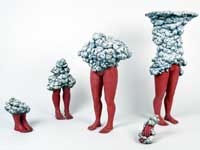 |
||
FRAGMENTED FIGURE |
| |
||||||||||
Frances Woodley Exhibited Works |
||||||||||
|
||||||||||
| |
||||||||||
Fragmentation in Frances Woodley’s Ceramicsby Natasha Mayo
|
||||||||||
|
Woodley’s ceramic pieces confront a viewer with the promise of narrative by demonstrating an event or occurrence, often in successive stages but without obvious beginning, middle or end. Their lack of structure blurs such literary conventions; a story is launched or suspended without clear idea of its future or ending. This ‘structural passivity’ according to Krauss, common to Surrealist practice, can in itself be intended as a thematic device, not only throwing a viewer directly into the core of activity but also suggesting an uncertain, jolting or hesitant portrayal of events.1 In Woodley’s composition ‘Six of One’, the absence of any progressive order in the relationship between hand and glove leaves one searching for alternative means of interpretation, one devoid of consequence or ultimate conclusion in the usual sense of an unravelling tale. The pairing of hand and glove is repeated six times. Whilst the hand remains fix in pose, identical in each composition, the glove writhes around seductively upon it, threading and twisting itself through fingers, mimicking their gesture, folding in on itself and lying as if in surrender across the palm. Woodley remarks upon this interaction as a reversal of roles, how the glove can appear as though persistently seeking attention and purpose in its relationship with the hand, rather than the hand seeking attention and purpose through its relationship with clothing.2 The behaviour of these objects has been altered, re-ordered from their usual or familiar roles. Whilst the use of the female hand and glove might commonly associate the work with notions of female body image and societal pressure, this blurring or probing of roles poses more fundamental questions about the structures by which we identify, interpret and value these objects. The disturbance of identities, systems and order are salient characteristics of Surrealism and appear intrinsic elements in Woodley’s ceramics. It is an approach that embraces an inherently fragmented nature. The blurring of categories between objects necessarily involves the taking away or removing of identities from their usual placement within our understanding of them; conventional means of interpreting their properties are disrupted. Ideas that might ordinarily relate to the properties of the hand and glove cannot remain central to their meaning as the distortion of their characteristics disturbs linear interpretation. The tendency is instead to treat the work less in the Modernist sense of being unique and visionary and more like a text to be deciphered according to existing methods of interpretation, calling our attention to, and questioning our use of, accepted categories, identities and spheres of association. ‘Six of One’ calls upon understanding of sexual difference - moreover socially established interpretation of sexual difference. The behaviour of the hand and glove reveal gendered characteristics: the hand remains static, singularly unchanged, original whilst the glove depicts an erratic movement, multiple in direction and constantly changing. Within this mode of interpretation, Freud’s definitions of gendered characteristics are elucidated.3 The concept of fragmentation in Woodley’s practice is expounded by connections to psychoanalysis, for this science, whilst attempting to categorise and explain human action, at the same time stands testimony to the failure of human communication and the inability of these divisions to contain our behaviour in absolute terms. Surrealism seizes possibilities presented by the space between established modes of evaluation and our changing perceptions. Fragmentation is embraced by way of categorical blurring, the breaking down of established structures and commentary upon the continual alteration of our identity(ies).
|
|
Foot notes1. Krauss, R., Bachelors, October Books, 1999, p.15 back to text 2. Woodley’s interpretation of ‘Six of One’ was recorded at the time of interview with the ‘Fragmented Figure’ curatorial team, April 2005. back to text 3. Freud, S., The standard Edition of the Complete Psychological Works of Sigmund Freud , vol. XIX
|
||||||||
| |
||||||||||
| University of Wales Intitute, cardiff | Adorfa Prifysgol Cymru, Caerdydd | ||||||||||

